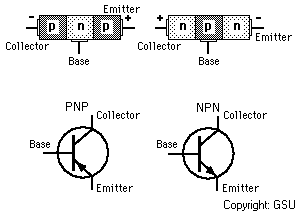How does a Transistor works.........?
There are two main types of transistors-junction transistors and field effect transistors. Each works in a different way. But the usefulness of any transistor comes from its ability to control a strong current with a weak voltage. For example, transistors in a public address system amplify (strengthen) the weak voltage produced when a person speaks into a microphone. The electricity coming from the transistors is strong enough to operate a loudspeaker, which produces sounds much louder than the person's voice.
JUNCTION TRANSISTORS
 A junction transistor consists of a thin piece of one type of semiconductor material between two thicker layers of the opposite type. For example, if the middle layer is p-type, the outside layers must be n-type. Such a transistor is an NPN transistor. One of the outside layers is called the emitter, and the other is known as the collector. The middle layer is the base. The places where the emitter joins the base and the base joins the collector are called junctions.
A junction transistor consists of a thin piece of one type of semiconductor material between two thicker layers of the opposite type. For example, if the middle layer is p-type, the outside layers must be n-type. Such a transistor is an NPN transistor. One of the outside layers is called the emitter, and the other is known as the collector. The middle layer is the base. The places where the emitter joins the base and the base joins the collector are called junctions.
There are two main types of transistors-junction transistors and field effect transistors. Each works in a different way. But the usefulness of any transistor comes from its ability to control a strong current with a weak voltage. For example, transistors in a public address system amplify (strengthen) the weak voltage produced when a person speaks into a microphone. The electricity coming from the transistors is strong enough to operate a loudspeaker, which produces sounds much louder than the person's voice.
JUNCTION TRANSISTORS
 A junction transistor consists of a thin piece of one type of semiconductor material between two thicker layers of the opposite type. For example, if the middle layer is p-type, the outside layers must be n-type. Such a transistor is an NPN transistor. One of the outside layers is called the emitter, and the other is known as the collector. The middle layer is the base. The places where the emitter joins the base and the base joins the collector are called junctions.
A junction transistor consists of a thin piece of one type of semiconductor material between two thicker layers of the opposite type. For example, if the middle layer is p-type, the outside layers must be n-type. Such a transistor is an NPN transistor. One of the outside layers is called the emitter, and the other is known as the collector. The middle layer is the base. The places where the emitter joins the base and the base joins the collector are called junctions.



